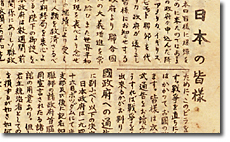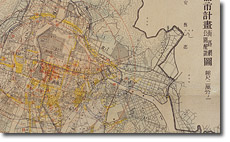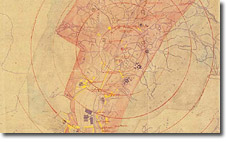HOME > Crisis in Constitutional Politics > d. Wartime Japan > Deterioration of War Situation
4-21 Deterioration of War Situation

Mushroom cloud rising above Nagasaki after explosion of atomic bomb Collection of the Japan Peace Museum From "Asahi Cronicle Shukan 20seiki Part1"
In 1945 (Showa 20), the United States intensified its bombing campaign of the Japanese mainland. The campaign included dropping various types of propaganda from the sky, leaflets, newspapers and other Japanese language documents printed in Hawaii and Manila. The aim was to wear down the will of the general population, and increasing their weariness of the war, by reminding their readers that the war was not necessarily going Japan's way. The documents also served as a kind of advance warning about where the next bombs would be targeted.
On 6 August 1945 (Showa 20), the United States dropped an atomic bomb on Hiroshima, and another one over Nagasaki three days later, causing enormous damage and untold casualties. Moreover, the Soviet Union's entry into the war against Japan on 8 August left Japan with no choice but to accept the Potsdam Declaration on 14 August. The war ended the next day.
The two maps seen here are found in a series of documents related to the war damage survey carried out by the Economic Stabilization Board after the war. They record the extent of physical damage in both Hiroshima and Nagasaki, particularly in the vicinity of the bombs' epicenters.
Pamphlets Dropped by U.S. Military on Japan
- July and August 1945 (Showa 20)
- Constitutional Government Documents Collection, #1235
- National Diet Library
Hiroshima Reconstruction: Urban Planning Map for Street Network and Park Layout (1:20,000 scale)
- December 1946 (Showa 21)
- Constitutional Government Documents Collection, #1220
- National Diet Library
Nagasaki City Map (1:10,000 scale)
- Constitutional Government Documents Collection, #1221
- National Diet Library


